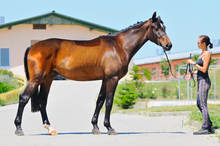One of the distinctions between The Masterson Method® and traditional massage is the role the horse plays in the process. With traditional massage, you are trained with your hands to findâthen âgo to workâ onâtension and anomalies in the muscle, using levels of pressure that will break them up.

Recognizing the level of touch that works for your horse
The horse is programmed to brace against or block out tension, pain or discomfort in order to survive and if the level of touch stays underneath the horseâs ability to block or brace, then his body will start to release the tension on its own.
With The Masterson Method, you listen to what the horseâs body has to say and adjust your pressure to get the result you want: the release from the horse. If there is any question about whether you are using the correct amount of pressure, the answer almost always is âless is more.â
The levels of pressure you use can range from almost nothing to about as much pressure as you can apply, depending on which area you are working on and what the horse is telling you.
Why is Touch so important when doing this work with the horse? For humans, if something is working well, we think that more of it will work even better. The opposite is true when using this Method on a horse.
The horse is programmed to brace against or block out tension, pain or discomfort in order to survive. If we use a level of touch that stays underneath the horseâs ability to block or brace, then his body will start to release the tension on its own.
With this Method the horse is the one doing the releasing. Weâre simply bringing the horseâs awareness to the tension in a way that he is unable to brace against it, either externally or internally. To make it easy to visualize, to avoid the use of technical terms - such as pounds per square inch - in describing what level of touch to use in any particular technique, we have developed more palpable descriptions below (that suspiciously have mostly to do with food.)
The key is to let the horseâs initial response, or lack of response, let you know if you are using too much pressure.
The following five terms are used to describe the different levels of pressure applied during a Masterson Method bodywork session:
- Air GapâBarely touching the surface. If you were to run your hand lightly down your arm, you would be barely brushing across the hairs on your arm.
- Egg YolkâThis is the amount of pressure it would take to barely indent a raw egg yolk with your fingertip. It might be a good idea to break an egg in a bowl to see how light this actually is.
- GrapeâThe amount of pressure it would take to indent a grape.
- Soft LemonâThe amount of pressure it would take to squeeze a soft, ripe lemon.
- Hard LimeâThe amount of pressure it would take to squeeze a hard, unripe lime. In some cases this can be just about as hard as you can push. We might apply Lime Pressure on certain areas and with certain techniques, if the horse is not bracing against it. And how do you know the horse is bracing, either internally or externally, against any level of pressure? By following the horseâs Responses â Visual and Palpable.
Through the use of light touch and gentle movement in a relaxed state, and observation of a range of the horse's responses (these visual and palpable responses tell you what the horse's body is feeling), you'll open doors to improved health and performance while enhancing communication with your horse.
Itâs easy to misjudge or miscalculate how much pressure you are using with these techniques. This can happen when you are first applying the techniques, and your focus is still on your body position and where to place your hands. However, the level of touch you use is the single most important thing that will determine the level of success you have!
For a detailed understanding of the Masterson Method, watch Jim talk about The Masterson Method® and its benefits and the process at: https://youtu.be/2sX8j9iQaMg
About Jim Masterson: Equine Massage Therapist for the 2006 â 2014 USEF Endurance Teams, and for equine clientele competing in FEI World Cup, Pan American and World Games competitions, teaches a unique method of equine bodywork for horse owners around the world.
About The Masterson Method® of Integrated Equine Performance Bodywork: The Masterson Method is an integrated, multi-modality method of equine massage. It is a unique, interactive method of equine massage in which you learn to recognize and use the responses of the horse to your touch to find and release accumulated tension in key junctions of the body that most affect performance.
In contrast to most traditional modalities, it enables the horse to actively participate in the process of releasing tension. It is something you do with the horse, rather than to the horse. This participation and interaction is what makes the method fascinating for those who use it. In fact, if you do not allow the horse to participate, it does not work!
To find out more about the Masterson Method® techniques, books and seminars leading to certification go to: https://mastersonmethod.com/masterson-method
